Jian Yin
A Pilot Empirical Study on When and How to Use Knowledge Graphs as Retrieval Augmented Generation
Feb 28, 2025Abstract:The integration of Knowledge Graphs (KGs) into the Retrieval Augmented Generation (RAG) framework has attracted significant interest, with early studies showing promise in mitigating hallucinations and improving model accuracy. However, a systematic understanding and comparative analysis of the rapidly emerging KG-RAG methods are still lacking. This paper seeks to lay the foundation for systematically answering the question of when and how to use KG-RAG by analyzing their performance in various application scenarios associated with different technical configurations. After outlining the mind map using KG-RAG framework and summarizing its popular pipeline, we conduct a pilot empirical study of KG-RAG works to reimplement and evaluate 6 KG-RAG methods across 7 datasets in diverse scenarios, analyzing the impact of 9 KG-RAG configurations in combination with 17 LLMs. Our results underscore the critical role of appropriate application conditions and optimal configurations of KG-RAG components.
Detecting Emotional Incongruity of Sarcasm by Commonsense Reasoning
Dec 17, 2024Abstract:This paper focuses on sarcasm detection, which aims to identify whether given statements convey criticism, mockery, or other negative sentiment opposite to the literal meaning. To detect sarcasm, humans often require a comprehensive understanding of the semantics in the statement and even resort to external commonsense to infer the fine-grained incongruity. However, existing methods lack commonsense inferential ability when they face complex real-world scenarios, leading to unsatisfactory performance. To address this problem, we propose a novel framework for sarcasm detection, which conducts incongruity reasoning based on commonsense augmentation, called EICR. Concretely, we first employ retrieval-augmented large language models to supplement the missing but indispensable commonsense background knowledge. To capture complex contextual associations, we construct a dependency graph and obtain the optimized topology via graph refinement. We further introduce an adaptive reasoning skeleton that integrates prior rules to extract sentiment-inconsistent subgraphs explicitly. To eliminate the possible spurious relations between words and labels, we employ adversarial contrastive learning to enhance the robustness of the detector. Experiments conducted on five datasets demonstrate the effectiveness of EICR.
Improving Multi-Subject Consistency in Open-Domain Image Generation with Isolation and Reposition Attention
Nov 28, 2024Abstract:Training-free diffusion models have achieved remarkable progress in generating multi-subject consistent images within open-domain scenarios. The key idea of these methods is to incorporate reference subject information within the attention layer. However, existing methods still obtain suboptimal performance when handling numerous subjects. This paper reveals the two primary issues contributing to this deficiency. Firstly, there is undesired interference among different subjects within the target image. Secondly, tokens tend to reference nearby tokens, which reduces the effectiveness of the attention mechanism when there is a significant positional difference between subjects in reference and target images. To address these challenges, we propose a training-free diffusion model with Isolation and Reposition Attention, named IR-Diffusion. Specifically, Isolation Attention ensures that multiple subjects in the target image do not reference each other, effectively eliminating the subject fusion. On the other hand, Reposition Attention involves scaling and repositioning subjects in both reference and target images to the same position within the images. This ensures that subjects in the target image can better reference those in the reference image, thereby maintaining better consistency. Extensive experiments demonstrate that the proposed methods significantly enhance multi-subject consistency, outperforming all existing methods in open-domain scenarios.
CoRe: Context-Regularized Text Embedding Learning for Text-to-Image Personalization
Aug 28, 2024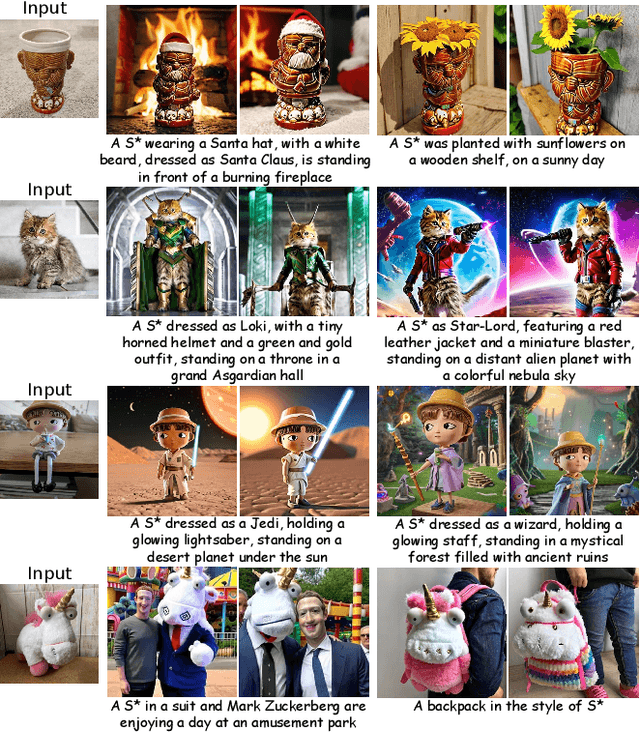
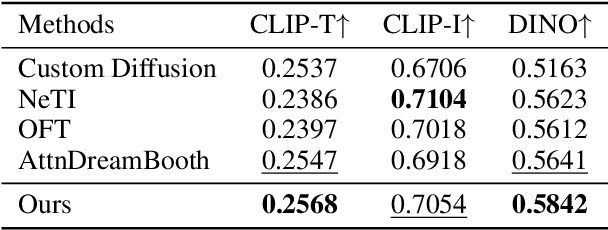

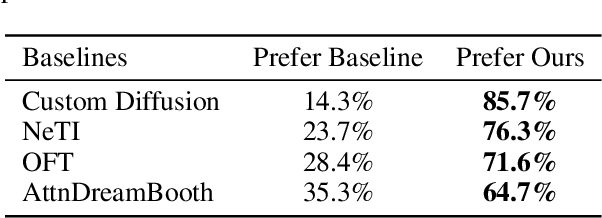
Abstract:Recent advances in text-to-image personalization have enabled high-quality and controllable image synthesis for user-provided concepts. However, existing methods still struggle to balance identity preservation with text alignment. Our approach is based on the fact that generating prompt-aligned images requires a precise semantic understanding of the prompt, which involves accurately processing the interactions between the new concept and its surrounding context tokens within the CLIP text encoder. To address this, we aim to embed the new concept properly into the input embedding space of the text encoder, allowing for seamless integration with existing tokens. We introduce Context Regularization (CoRe), which enhances the learning of the new concept's text embedding by regularizing its context tokens in the prompt. This is based on the insight that appropriate output vectors of the text encoder for the context tokens can only be achieved if the new concept's text embedding is correctly learned. CoRe can be applied to arbitrary prompts without requiring the generation of corresponding images, thus improving the generalization of the learned text embedding. Additionally, CoRe can serve as a test-time optimization technique to further enhance the generations for specific prompts. Comprehensive experiments demonstrate that our method outperforms several baseline methods in both identity preservation and text alignment. Code will be made publicly available.
DreamStory: Open-Domain Story Visualization by LLM-Guided Multi-Subject Consistent Diffusion
Jul 17, 2024


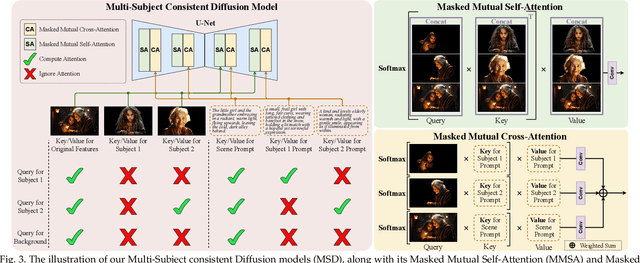
Abstract:Story visualization aims to create visually compelling images or videos corresponding to textual narratives. Despite recent advances in diffusion models yielding promising results, existing methods still struggle to create a coherent sequence of subject-consistent frames based solely on a story. To this end, we propose DreamStory, an automatic open-domain story visualization framework by leveraging the LLMs and a novel multi-subject consistent diffusion model. DreamStory consists of (1) an LLM acting as a story director and (2) an innovative Multi-Subject consistent Diffusion model (MSD) for generating consistent multi-subject across the images. First, DreamStory employs the LLM to generate descriptive prompts for subjects and scenes aligned with the story, annotating each scene's subjects for subsequent subject-consistent generation. Second, DreamStory utilizes these detailed subject descriptions to create portraits of the subjects, with these portraits and their corresponding textual information serving as multimodal anchors (guidance). Finally, the MSD uses these multimodal anchors to generate story scenes with consistent multi-subject. Specifically, the MSD includes Masked Mutual Self-Attention (MMSA) and Masked Mutual Cross-Attention (MMCA) modules. MMSA and MMCA modules ensure appearance and semantic consistency with reference images and text, respectively. Both modules employ masking mechanisms to prevent subject blending. To validate our approach and promote progress in story visualization, we established a benchmark, DS-500, which can assess the overall performance of the story visualization framework, subject-identification accuracy, and the consistency of the generation model. Extensive experiments validate the effectiveness of DreamStory in both subjective and objective evaluations. Please visit our project homepage at https://dream-xyz.github.io/dreamstory.
Cross-domain-aware Worker Selection with Training for Crowdsourced Annotation
Jun 11, 2024Abstract:Annotation through crowdsourcing draws incremental attention, which relies on an effective selection scheme given a pool of workers. Existing methods propose to select workers based on their performance on tasks with ground truth, while two important points are missed. 1) The historical performances of workers in other tasks. In real-world scenarios, workers need to solve a new task whose correlation with previous tasks is not well-known before the training, which is called cross-domain. 2) The dynamic worker performance as workers will learn from the ground truth. In this paper, we consider both factors in designing an allocation scheme named cross-domain-aware worker selection with training approach. Our approach proposes two estimation modules to both statistically analyze the cross-domain correlation and simulate the learning gain of workers dynamically. A framework with a theoretical analysis of the worker elimination process is given. To validate the effectiveness of our methods, we collect two novel real-world datasets and generate synthetic datasets. The experiment results show that our method outperforms the baselines on both real-world and synthetic datasets.
AttnDreamBooth: Towards Text-Aligned Personalized Text-to-Image Generation
Jun 07, 2024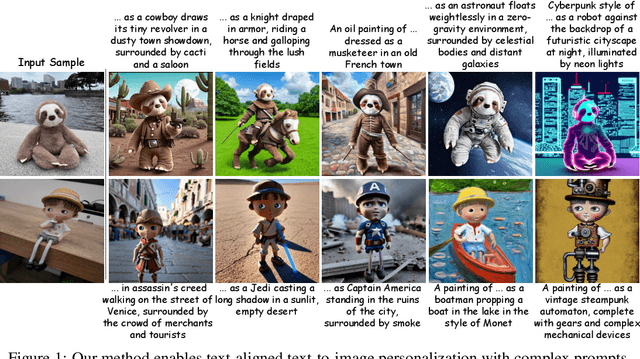
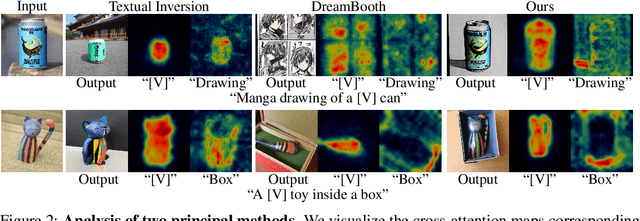


Abstract:Recent advances in text-to-image models have enabled high-quality personalized image synthesis of user-provided concepts with flexible textual control. In this work, we analyze the limitations of two primary techniques in text-to-image personalization: Textual Inversion and DreamBooth. When integrating the learned concept into new prompts, Textual Inversion tends to overfit the concept, while DreamBooth often overlooks it. We attribute these issues to the incorrect learning of the embedding alignment for the concept. We introduce AttnDreamBooth, a novel approach that addresses these issues by separately learning the embedding alignment, the attention map, and the subject identity in different training stages. We also introduce a cross-attention map regularization term to enhance the learning of the attention map. Our method demonstrates significant improvements in identity preservation and text alignment compared to the baseline methods.
Proving Theorems Recursively
May 23, 2024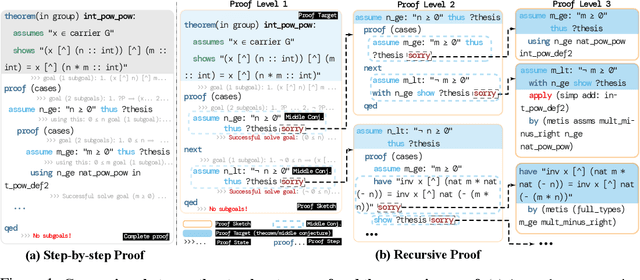

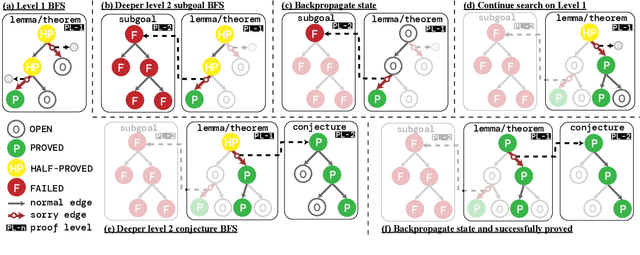
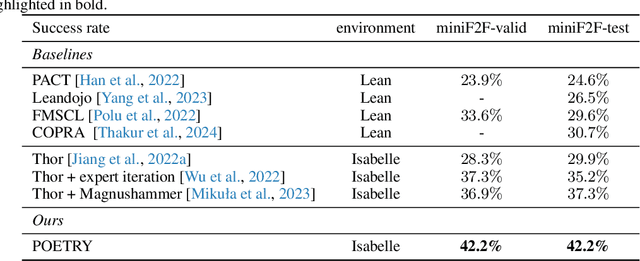
Abstract:Recent advances in automated theorem proving leverages language models to explore expanded search spaces by step-by-step proof generation. However, such approaches are usually based on short-sighted heuristics (e.g., log probability or value function scores) that potentially lead to suboptimal or even distracting subgoals, preventing us from finding longer proofs. To address this challenge, we propose POETRY (PrOvE Theorems RecursivelY), which proves theorems in a recursive, level-by-level manner in the Isabelle theorem prover. Unlike previous step-by-step methods, POETRY searches for a verifiable sketch of the proof at each level and focuses on solving the current level's theorem or conjecture. Detailed proofs of intermediate conjectures within the sketch are temporarily replaced by a placeholder tactic called sorry, deferring their proofs to subsequent levels. This approach allows the theorem to be tackled incrementally by outlining the overall theorem at the first level and then solving the intermediate conjectures at deeper levels. Experiments are conducted on the miniF2F and PISA datasets and significant performance gains are observed in our POETRY approach over state-of-the-art methods. POETRY on miniF2F achieves an average proving success rate improvement of 5.1%. Moreover, we observe a substantial increase in the maximum proof length found by POETRY, from 10 to 26.
CPT: Competence-progressive Training Strategy for Few-shot Node Classification
Feb 01, 2024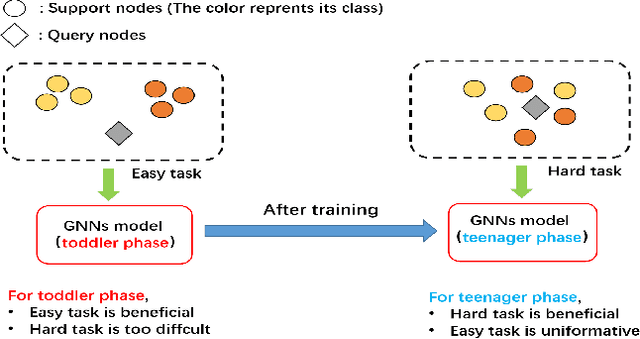
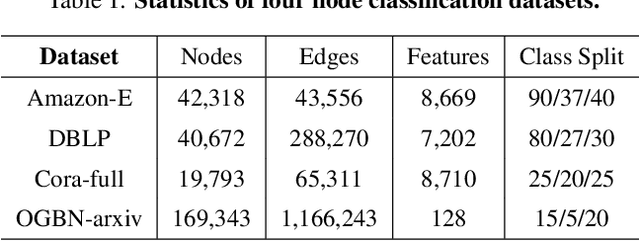


Abstract:Graph Neural Networks (GNNs) have made significant advancements in node classification, but their success relies on sufficient labeled nodes per class in the training data. Real-world graph data often exhibits a long-tail distribution with sparse labels, emphasizing the importance of GNNs' ability in few-shot node classification, which entails categorizing nodes with limited data. Traditional episodic meta-learning approaches have shown promise in this domain, but they face an inherent limitation: it might lead the model to converge to suboptimal solutions because of random and uniform task assignment, ignoring task difficulty levels. This could lead the meta-learner to face complex tasks too soon, hindering proper learning. Ideally, the meta-learner should start with simple concepts and advance to more complex ones, like human learning. So, we introduce CPT, a novel two-stage curriculum learning method that aligns task difficulty with the meta-learner's progressive competence, enhancing overall performance. Specifically, in CPT's initial stage, the focus is on simpler tasks, fostering foundational skills for engaging with complex tasks later. Importantly, the second stage dynamically adjusts task difficulty based on the meta-learner's growing competence, aiming for optimal knowledge acquisition. Extensive experiments on popular node classification datasets demonstrate significant improvements of our strategy over existing methods.
Cross Initialization for Personalized Text-to-Image Generation
Dec 26, 2023Abstract:Recently, there has been a surge in face personalization techniques, benefiting from the advanced capabilities of pretrained text-to-image diffusion models. Among these, a notable method is Textual Inversion, which generates personalized images by inverting given images into textual embeddings. However, methods based on Textual Inversion still struggle with balancing the trade-off between reconstruction quality and editability. In this study, we examine this issue through the lens of initialization. Upon closely examining traditional initialization methods, we identified a significant disparity between the initial and learned embeddings in terms of both scale and orientation. The scale of the learned embedding can be up to 100 times greater than that of the initial embedding. Such a significant change in the embedding could increase the risk of overfitting, thereby compromising the editability. Driven by this observation, we introduce a novel initialization method, termed Cross Initialization, that significantly narrows the gap between the initial and learned embeddings. This method not only improves both reconstruction and editability but also reduces the optimization steps from 5000 to 320. Furthermore, we apply a regularization term to keep the learned embedding close to the initial embedding. We show that when combined with Cross Initialization, this regularization term can effectively improve editability. We provide comprehensive empirical evidence to demonstrate the superior performance of our method compared to the baseline methods. Notably, in our experiments, Cross Initialization is the only method that successfully edits an individual's facial expression. Additionally, a fast version of our method allows for capturing an input image in roughly 26 seconds, while surpassing the baseline methods in terms of both reconstruction and editability. Code will be made publicly available.
 Add to Chrome
Add to Chrome Add to Firefox
Add to Firefox Add to Edge
Add to Edge